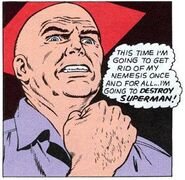The following individuals all have the name of "Lex Luthor" or used "Lex" as one of their primary aliases/nicknames in addition to having the base family of Luthor.
See Luthor for a wider association of individuals who have the family name of Luthor.
The actual specific history of the Luthor character is very different from what many know as when the character first appeared he was portrayed with a full head of red hair and was not even actually given a specific first name. This verison would later become known as ALEXEI Luthor. But the original character with his full head of red hair and foreign accent and vast superscience was brought back, merely renamed as Per Degaton, in 1947.
In 1941, the Luthor character came to be portrayed as completely bald after an artist's mistake in the Superman comic strip. Shuster preferred drawing bald villains anyway, so the more striking appearance was adopted and became a Luthor trademark. The change may also have been an attempt to echo a previous villain, the Ultra-Humanite, with whom Luthor shares many similarities. When the DC multiverse began to take hold in the 1960s, the red-haired Luthor was said to be the bald Luthor's Earth-Two counterpart, Alexei Luthor. Though the original red-haired European scientist character had been used since 1947 in the renamed persona of Per Degaton. According to one source, the character was renamed to prevent confusion on the part of the reader who would not be able to recall which Luthor was which if the original incarnation of the character was maintained as Luthor alongside of the newer one. Strangely enough this idea would be brought back and accepted in the Multiverse in the 1960s when the Justice Society was btought back into the DC storyline.
The original Luthor of the 1940s was one of many pulps-inspired mad scientists who plotted to take over the world, or destroy it, through the use of various diabolical schemes. He donned disguises a few times, but generally he preferred to make himself known to the world as his master plans came to fruition... until he was foiled, time and time again, by Superman. He soon became Superman's greatest foe, the antithesis of everything Superman stood for; and even though his plans for world domination were repeatedly dashed, he always managed to get away (or escape from prison) to threaten the world time and time again.
Luthor's originally stated goals were to kill Superman and to take over Earth as a stepping stone to dominating the universe. Over the years, Luthor came up with every conceivable plan to destroy Superman: he has synthesized kryptonite; traveled back in time; summoned beings from the fourth dimension; created robots, clones, and genetic monstrosities; allied himself with the alien super-computer android Brainiac; animated kryptonite rocks; detonated H-bombs; and has masqueraded and taken on a number of aliases. Although none of his schemes worked permanently (though one classic non-canonical "imaginary story" from the 1960s called The Death of Superman has Luthor finally killing Superman with Kryptonite after lulling him by pretending to go straight), Luthor's persistence has made him Superman's most troublesome foe.
In Adventure Comics #271 in 1960 (written by Jerry Siegel), the Silver Age origin of Luthor is first revealed, along with Luthor finally gaining a first name, "Lex." It was revealed that when Luthor was a teenager, his family moved to Smallville, with Lex becoming a large fan of Superboy. In gratitude and to encourage Lex's scientific pursuits, Superboy built for Lex a fully stocked laboratory. There, Lex began an experiment in creating an artificial new form of life, along with a cure for kryptonite poisoning. However, when a fire caught in his lab, Superboy mistakenly used his super-breath to extinguish the flames. This rescue attempt spilled chemicals that caused Luthor to go prematurely bald and destroyed both his kryptonite cure and his artificial life form. Luthor attributed Superboy's actions to jealousy and vowed revenge. First, he tried to show Superboy up with grandiose technological projects to improve the life of Smallville's residents, which time and again went dangerously out of control and required Superboy's intervention. Unwilling to accept responsibility for these accidents, Lex rationalized that Superboy was out to humiliate him and vowed to spend the rest of his life proving to the world he was Superboy's (and later Superman's) superior by eliminating the hero.
This origin first made Luthor's fight with Superman a personal one, giving him a dimension beyond his previous mad scientist archetype and suggesting that if events had unfolded differently, Luthor might have become a more noble person; these elements were played up in various stories in the 1970s and 1980s, particularly in Elliot S. Maggin's text novel Last Son of Krypton.
Though he was a noted villain and an evil mastermind on Earth, Luthor was revered as a hero on the alien world of Lexor, where he used his scientific genius to rediscover the planet's technology and rebuild society for the inhabitants. Luthor used the planet as a base for his operations to strike against Superman using equipment such as the distinctive and flight capable purple and green suit he took to wearing in stories starting in the 1970s. The last such attempt on Lexor destroyed the planet and killed all of its inhabitants, including his wife there. Though aggrieved, Lex refused to accept that he was responsible and blamed Superman.
In Action Comics #544 in 1983, Lex was given a makeover for Superman's 45th anniversary in comics, by gaining a purple-and-green colored battlesuit that gave him the ability to take on Superman singlehandedly.
Superman himself has acknowledged that Luthor is a man of his word who would honor promises he made. Luthor had a younger blond-haired sister, Lena Thorul (shamed by Lex's criminal acts, the Luthors disowned him, moved away and changed their name to the anagram "Thorul"), an empath who grew up unaware of her familial connection with the noted villain. Protective of his sister, Luthor had strived to hide his connection and had been assisted towards this end by both Supergirl and Superman.
In 1986, John Byrne's "reboot" of Superman's mythos in the miniseries The Man of Steel rewrote the character of Lex Luthor from scratch, intending to make him a villain that the 1980s readers would recognize: a corporate white-collar criminal (the idea was originally suggested by Marv Wolfman). Under other writers, he eventually became a behind-the-scenes manipulator.



